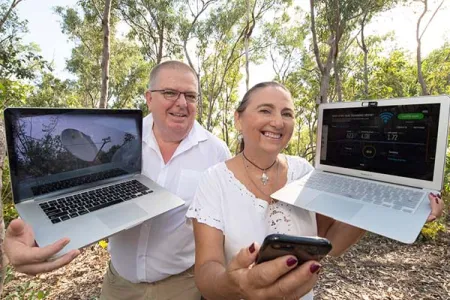Telehealth a game changer in the bush
Research by Charles Darwin University (CDU) and an Arnhem Land community health service has identified huge benefits from the recent implementation of high-quality internet and telehealth in the Laynhapuy Homelands.
The research was published recently in the Medical Journal of Australia and was a collaboration between CDU and Laynhapuy Aboriginal Community Controlled Health Services (LHS). Other project partners were Aboriginal Medical Services Alliance NT, LHS, local ICT company eMerge, Telstra Health and the Broadband for the Bush Alliance.
The Regional Economic Infrastructure Fund provided about $400,000 to establish high-quality satellite internet services in three very remote communities, implement telehealth and demonstrate its benefits.
These communities are about 750 kilometres east of Darwin and 200 km south of Nhulunbuy, the nearest major regional centre. Each is home to about 100 people and serviced by unsealed roads that are often impassable in the wet season.
Researchers investigated how telehealth could benefit the community in terms of access to health care, including specialist health services.
Northern Institute Research Fellow, Marianne St Clair said the reliable internet connection and telehealth videoconferencing systems in the communities proved to be a game changer in remote Aboriginal health service delivery.
“Prior to the implementation of videoconferencing for telehealth these communities relied on the phone to contact their GP and had to travel to Nhulunbuy or Darwin to see specialists,” Miss St Clair said.
Face-to-face consultations via telehealth and direct supervision and observation of patients has improved diagnostic and treatment abilities as well as facilitating improved communication. Telehealth consultations with specialists allow the patient’s regular nurse, Aboriginal Health professional and GP to participate as well as family members. Telehealth has facilitated group decision-making even if family members are in other communities.
Aboriginal people in these very remote areas practise group decision-making, which involves the whole family, many of whom can be spread over large geographical areas. Videoconferencing allows family members, clinicians and the patient to discuss the issue and the treatment required allowing more responsive decision-making.
“Without this technology it can sometimes take months for decisions to be made by family members about crucial clinical procedures,” she said.
The research found telehealth allows more accurate decisions to be made about medical evacuations and acute care retrievals as the clinician can “virtually” examine the patient. Implementation of telehealth also has provided access to a wider range of specialist services.
Offsite medical professionals in Nhulunbuy, Darwin or Sydney can assess the injury and send a recording of the assessment to a specialist or surgeon for advice. The research found this process allowed injuries that would otherwise have required evacuation to be treated in the community improving service delivery, the patient experience and saving patient travel costs.
Joint author, Northern Institute Research Fellow David Murtagh said the technology also had the capacity to build skills at the community health level.
“Supervising GPs or physicians can directly observe examinations and provide immediate feedback and education to community health staff on techniques and practices. This improves patient safety, skills of the health workers and provides on-site professional development.
“This creates the capacity to ensure treatment is done in the most culturally sensitive way possible by all staff including trainees or new staff,” he said.
The research team found that implementation of telehealth in other communities in the homelands requires access to reliable and adequate broadband internet and a simpler, more robust videoconferencing system.
The team plans to address this in the next phase of research as well as integrating smart diagnostic tools such as audio stethoscopes.
